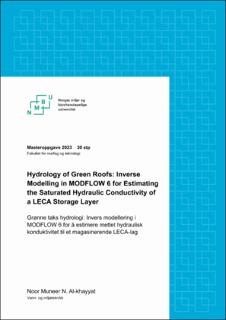| dc.description.abstract | This thesis presents a study on the modelling of green roofs as a stormwater management tool using MODFLOW 6 with the ModelMuse interface. The objective of the research is to evaluate the reliability and capability of MODFLOW 6 as a modelling tool for green roofs and to estimate the hydraulic conductivity of the drainage layer on green roofs. The research work is based on a steady-state experiment conducted on the green roof (4cm of sedum and 15cm of Lightweight Expanded Clay Aggregate; LECA 0-6mm) at the research facility for green roofs at the Norwegian University of Life Sciences (NMBU). The roof was constructed in 2018 and monitored since then, with live data logging from eight water head sensors, and recording of run-off, precipitation, temperature, and several other hydrological parameters.
The use of MODFLOW 6 to simulate the flow in green roofs is not as common as its use as a simulating tool for groundwater flow. In this thesis, the reliability of MODFLOW to model the flow in green roofs under steady-state conditions was successfully evaluated by matching the modelling result with an analytical solution of the flow equations in the drainage layer of the green roof.
In this research work, the model was calibrated for hydraulic conductivity ( ) against the observation data from 8 sensors representing the hydraulic head in the green roof. The calibration processes were carried out using both manual calibrations with the Mean Absolute Error (MAE) as the objective function, and inverse modelling with the Parameter ESTimation (PEST) modelling in MODFLOW 6.
The results of this work showed that the model was able to accurately predict the hydraulic conductivity based on the observed hydraulic head in the green roof. Based on the modelling of the steady-state experiment, the hydraulic conductivity of LECA 0-6mm as the drainage layer of the green roof was estimated as . This modelled value closely approximates the laboratory-measured value . Furthermore, It has been found that the lower values of hydraulic conductivity ( ) made the hydraulic head rise higher than the thickness of the drainage layer, while the higher values ( ) made the model dry. Additionally, It was discovered that The calibrated K-value is relatively insensitive to the choice of boundary condition, i.e. the head value at the drain outlet.
MODFLOW 6 proved to be a very robust and powerful physical-based modelling tool that was able to effectively simulate the steady flow in the drainage layer of the green roof in this research work. For the transient flow model which simulates the scenario of time-depending precipitation (unsteady-state conditions), MODFLOW 6 should be evaluated and more research should be conducted. | |
